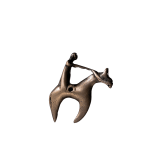Open a larger version of the following image in a popup:
 Horse-and-rider shaped Amulet
Horse-and-rider shaped Amulet
 Horse-and-rider shaped Amulet
Horse-and-rider shaped Amulet
Open a larger version of the following image in a popup:
 Horse-and-rider shaped Amulet
Horse-and-rider shaped Amulet
 Horse-and-rider shaped Amulet
Horse-and-rider shaped Amulet
Open a larger version of the following image in a popup:
 Horse-and-rider shaped Amulet
Horse-and-rider shaped Amulet
 Horse-and-rider shaped Amulet
Horse-and-rider shaped Amulet
Open a larger version of the following image in a popup:
 Horse-and-rider shaped Amulet
Horse-and-rider shaped Amulet
 Horse-and-rider shaped Amulet
Horse-and-rider shaped Amulet
Open a larger version of the following image in a popup:
 Horse-and-rider shaped Amulet
Horse-and-rider shaped Amulet
 Horse-and-rider shaped Amulet
Horse-and-rider shaped Amulet
Anonymous Kotoko artist
Horse-and-rider shaped Amulet
metal
origin: Chad - early 20th century
origin: Chad - early 20th century
5.5 x 5 x 0.5 cm
2 1/8 x 2 x 1/4 in
2 1/8 x 2 x 1/4 in
custom made wooden base included
Photo: Valentin Clavairolles
Sold
Further images
Kotoko metalworkers in the vicinity of Lake Chad used the lost-wax technique to cast small bronze figurines that were kept as personal amulets. Functioning as protective talismans, they were once...
Kotoko metalworkers in the vicinity of Lake Chad used the lost-wax technique to cast small bronze figurines that were kept as personal amulets. Functioning as protective talismans, they were once worn around an owner’s neck or in a small pouch. Held close to the body, they safeguarded their owners against threats outward, and physical, or inward, in the form of anxiety and mental illness. Many of these amulets depict horse riders and are locally known as putchu guinadj. The iconography of the horse and rider originally comes from the Peul warriors who fought and enslaved many of the animistic tribes in the region. The Kotoko themselves did not ride horses, but were farmers and fishermen living along the Logone and Chari rivers. The word „Putchu“ means horse and „Guinadji“ means demon in the Kotoko language. The „Putchu Guinadji“ are thus the horse and the rider who fight the demons attacking a mad person – in other words they are imbued with implicit hope that ‘Troubles may yet ride away’. The extensive wear, indicative of a long medicinal use, of the present amulet gives the surface a very smooth finish. The elegance and refined beauty of this talisman set it apart as one of the most beautiful examples of the type.
Provenance
Ethan Rider, Oackland, US
Duende Art Projects, Antwerp, Belgium, 2021
let's keep in touch
Join our community & never miss out on a DUENDE moment from now on
* denotes required fields
We will process the personal data you have supplied to communicate with you in accordance with our Privacy Policy. You can unsubscribe or change your preferences at any time by clicking the link in our emails.




